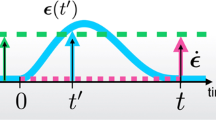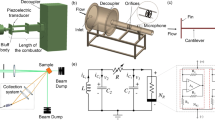Abstract
THE dynamical theory of dispersion, as originally given by Sellmeier,2 consisted in finding the velocity of light as affected by vibratory molecules embedded in ether, such as those which had been suggested by Stokes3 to account for the dark lines of the solar spectrum. Sellmeier's mathematical work was founded on the simplest ideal of a molecular vibrator, which may be taken as a single material particle connected by a massless spring or springs with a rigid lining of a small vesicle in ether. He investigated the propagation of distortional waves, and found the following expression (which I give with slightly altered notation) for the square of the refractive index of light passing through ether studded with a very large number of vibratory molecules in every volume equal to the cube of the wavelength:—
This is a preview of subscription content, access via your institution
Access options
Subscribe to this journal
Receive 51 print issues and online access
$199.00 per year
only $3.90 per issue
Buy this article
- Purchase on Springer Link
- Instant access to full article PDF
Prices may be subject to local taxes which are calculated during checkout
Similar content being viewed by others
References
Sellmeier, Pogg. Ann., vol. 145, 1872, pp. 399, 520; vol. 147, 1872, pp. 386, 525.
See Kirchhoff-Stokes-Thomson, Phil. Mag., March and July 1860.
Fox-Talbot, Proc. Roy. Soc. Edin., 1870–71.
Leroux, Comptes rendus, 55, 1862, pp. 126–128.
Christiansen, Ann. Phys. Chem., 141, 1870, pp. 479, 480; Phil. Mag., 41, 1871, p. 244; Annales de Chimie, 25, 1872, pp. 213, 214.
Kundt, Pogg. Ann., vols. 142, 143, 144, 145, 1871–72.
Pogg. Ann., vol. 147, 1872, p. 525.
Wied. Ann., vol. 53, 1894, p. 267. In the formula quoted by Rubens from Ketteler, substitute for the value of found by putting = in Sellmeier's formula, and Ketteler's formula becomes identical with Sellmeier's. Remark that Ketteler's "M" is Sellmeier's "m2" according to my notation in the text.
Langley, Phil. Mag., 1886, 2nd half-year.
Rubens, Wied. Ann., vols. 53, 54, 1894–95.
Rubens, Wied. Ann., vol. 60, 1896–97, p. 454.
Rubens, and Aschkinass, Wied. Ann., vol. 64, 1898.
Rights and permissions
About this article
Cite this article
The Dynamical Theory of Refraction, Dispersion and Anomalous Dispersion1. Nature 58, 546–547 (1898). https://doi.org/10.1038/058546e0
Issue Date:
DOI: https://doi.org/10.1038/058546e0
Comments
By submitting a comment you agree to abide by our Terms and Community Guidelines. If you find something abusive or that does not comply with our terms or guidelines please flag it as inappropriate.



